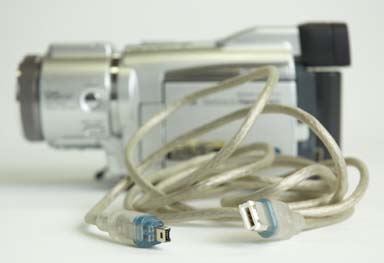The FireWire jack on the front, side, or back of your computer is marked by a radio-active-looking ![]() symbol.
symbol.
If you intend to edit your own camcorder footage, you’ll also need a FireWire cable, like the one shown in Figure 4-1.
Figure 4-1. Plug the larger end of the FireWire cable—the six-pin end, as Apple calls it—into the corresponding jack on the Mac. The tiny end may look almost square, but it fits only in one particular way, thanks to a little indentation on one side. Be gentle with it.
On the other end is a much smaller, squarish plug (the four-pin connector). Plug this tiny end into the FireWire connector on your camcorder, which, depending on the brand, may be labeled “FireWire,""i.Link,” or “IEEE 1394.”
This single FireWire cable communicates both sound and video, in both directions, between the Mac and the camcorder.
Now, if you plan to transfer video to your Mac from a tape in the camcorder, you should turn the camcorder to its VCR or VTR mode.
Tip
Occasionally, you may even want to capture live video into iMovie—to pass whatever your camcorder lens is seeing directly to the Mac, without ever recording it on tape. In that case, put the camcorder into Camera mode instead.
For best results, plug in your camcorder’s power adapter instead of running it from battery power. At last, you’re ready to begin editing video!
Get iMovie 6 & iDVD: The Missing Manual now with the O’Reilly learning platform.
O’Reilly members experience books, live events, courses curated by job role, and more from O’Reilly and nearly 200 top publishers.


